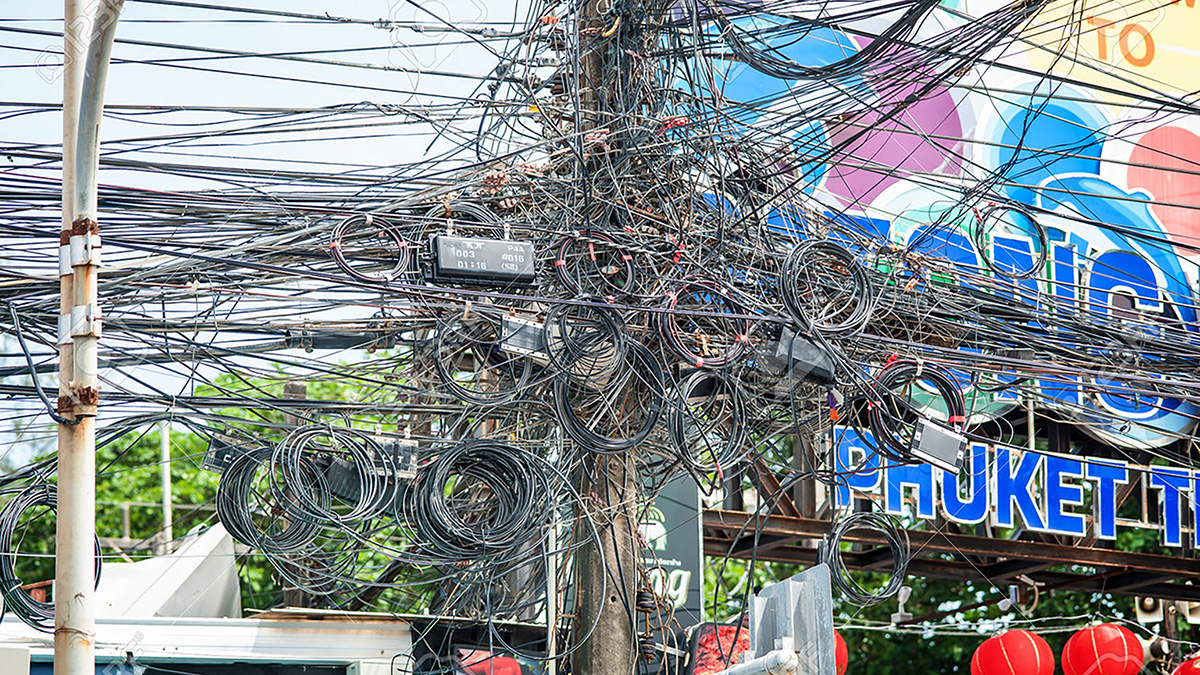When the NBN spouts about their latest and greatest services soon coming to your area, and you’ve been waiting for the service since 2008, then G.Fast (Gfast) might be the NBN alternative for you.
Contents
For all those users like myself who still don’t have access to an NBN Fibre to the Premises (FTTP) service – a solution has now arrived that is not only a respectable substitute but works in the delivery of decent high-speed WAN (internet) services to the home or office for those still unable to access fibre to your premises.
Working in the IT, security and even gaming industries, a high-speed internet service becomes a hugely important factor in maintaining a level of sanity when dealing with applications that require high speed and low latency, nothing of which can compare to an optic fibre service directly to your premises, i.e. Fibre to the Premises (FTTP).
I recall the excitement when it was announced in 2008 that the South Brisbane FTTP NBN testing area (known as the Telstra South Brisbane Fibre Network at the time, now sold to Telstra Velocity), was successful and the NBN was to be rolled out across the country, for each and every Australian who wanted high-speed internet.
Finally, Australia was to be elevated into the upper echelon of those supreme countries like Macau, Taiwan, Japan, and Singapore, all of which had fast internet services 10 years prior since 2000(1), while we battled the latency of an asymmetric digital subscriber line 1 (ADSL) trying to upload server ISO’s on 128kps.

Alas, it was not to be. Some small group of bureaucrats in the government at the time could not, would not, or refused to understand or take the time to learn the vast importance and immense positive impact such a technology would have on Australian consumers, businesses, and the country as a whole. Instead, 25 years later, many of us living in strata premises or apartments still cannot access the NBN.
How wrong the government was at the time! (2) In an effort to save costs, they effectively doubled/tripled the cost, causing unimaginable losses to the Australian economy and all against the better judgement of the majority of the Australian people.
Their solution was a travesty to mankind, justice and the technology world at large. After living for many years with the promise of super-fast internet (just like the rest of the modern and developing worlds), our expectations were raised to great heights like the flight path of a Concord, only to have them come crashing down and obliterated in the space of a few days.
The Broken Promise
For those unable to access any FTTP or cable service, the government’s solution was to utilise the exact same copper cabling infrastructure that we already were using for our ADSL 2+ services installed by Telstra back in the 1990’s.
Essentially, a large part of the cost came from the lead-in cabling that joins the fibre cable in the street to the MDF in the premises, apartment or house. The cabling would only go as far as an MDF in the premises and the rest of the way, the ‘last mile‘, would utilise the current copper cabling already in place.
At the termination point in a comms room somewhere in the apartment block, there is a basic media converter, converting the optic fibre to ethernet; then a patch panel connecting the lead in cabling to each apartment using the copper phone lines as the method of delivering the signal to each apartment.
Each apartment then connects its router to the phone line and logs into the service to access their less-than-ideal speeds of around 100 Mps at most.
The Real Loss
So what is the difference? Does it really matter? Let’s take a look at some of the standard benchmarks. The table below for the performance of FTTP vs FTTN/B vs Satellite.
| SERVICES | RESULTS |
|---|---|
| Promised Speed (FTTP) | 1000 Mbps |
| Latency – Ping Test (FTTP) | 2 ms |
| Jitter (FTTP) | 0 |
| Delivered Speed (FTTB/N) | 100 Mbps (at most) |
| Real Latency – Ping Test (FTTB/N) | 9 ms |
| Jitter (FTTB/N) | 0 |
| Delivered Speed (Starlink Sat) | 300 Mbps |
| Latency – Ping Test (Starlink Sat) | 55 ms |
| Jitter (Starlink Sat) | 4 ms |
The answer is absolutely!
Get a Quote
Of course, if you want to pay for the last mile of cable yourself, you can organise a quote from the nbn here. My quote for a 50-metre fibre run came in at $12,000. LOL.
What is Fibre to the Basement (FTTB)
Let’s fast forward to 2024 and look at where we now stand in all this ruckus. A less than careful observation immediately reveals that much has been done in the past 5 years to bring Australia’s internet standards up to speed.
Many of the buildings in inner-city areas and even rural areas have now been given a promise of an FTTP service. The FTTP upgrade program (also known as Fibre Connect) is an initiative run by the NBN implemented early in 2024 and designed to provide customers with faster internet to support the growth in connected devices and increase the number of Australians working from home.
This was recently announced by the NBN and is excellent news for consumers and businesses on the last leg of a fibre install progressing in their street or suburb. We must say that, finally, things are starting to look a little up (after 20 years).
Still No NBN FTTP for Many
Unfortunately, many of us live in apartments or strata buildings and still cannot and will not be able to access an FTTP service. There are also currently no plans afoot to provide lead-in cabling to those in this situation.
Why is this the case? Unfortunately, many apartment blocks require additional fibre optic cabling installed from the basement to each apartment to receive a fast FTTP service. In large apartment blocks with well over 500 apartments, there is a level of cost associated with such an installation. Moreover, getting the job done neatly without cabling being left in loose conduits everywhere is another story altogether.
There is a large grey area regarding who should foot the bill for this lead in cabling: the body-corporate in question or the government.
The Solution: G.fast
Thanks to recent developments in digital subscriber line (DSL) protocol standards, a new technology G.fast (Gfast) which has only become available in the past few weeks, is now available for those who cannot access FTTP.
Most importantly of all, it actually works!
Being in the IT industry, we were looking for a solution that could provide a decent high-speed service and came across a company Capti Networks Pty Ltd, who are one of the first to offer G.fast (Gfast) services to our local area (Artarmon, NSW).
At the time, we spoke to Capti engineers and management, who placed us on a waiting list for the service. Being sceptical at first, I was unsure how the service would perform or how long it would take to implement.
It turned out that the equipment for the service was already in place in the basement comms room of the apartment block, and we were told there was a short final wait for several small fibre runs to be completed before the service was activated.
Before the upgrade, we pulled the face plates off the wall and dug out the old Telstra shielded twisted pair (UTP) cables to cut and re-terminate as the current fittings were quite corroded. This just ensures maximum speed for a new service.
True to their word, the service was activated on time, and the technician arrived with the VDSL G.fast (Gfast) modem. Upon testing, we can vouch that the speeds are just super impressive for a DSL service. It rivals an nbn™ FTTP and only falls slightly short due to the expected latency. Our most recent speed test shows the following:
Let’s look at the full results tested across various core services. The above test was completed cross-service from Capti to a Telstra backbone in the Equinix Data Centre. Please feel free to click on the image to enlarge.
You can see the latency is still relatively low and well within acceptable limits for gaming or working on remote cloud services via RDP or VNC, where every millisecond of packet loss means life or death.
Here is a ping test from the G.fast (Gfast) service to a local Google server showing a latency of 4ms and a TTL of 119 – not bad!

Cost
Surprisingly, the cost of Gfast is reasonable. For the provider in question, we can note the following prices as of 11.03.2024:
| Download Speed | Upload Speed | Quota | Price P/Mth | Type |
|---|---|---|---|---|
| | Unlimited | $69.00 | Gfast | |
| | Unlimited | $89.00 | Gfast | |
| | Unlimited | $109.00 | Gfast |
Currently, we cannot compare the pricing to that of another provider due to the fact that no other G.fast (Gfast) providers are currently supplying services in NSW as of the date of this article writing.
Conclusion
Considering the above benchmarks, it becomes immediately apparent that G.fast becomes an excellent substitute for those who cannot access an NBN fibre service to the premises (FTTP).
The pricing of G.fast (Gfast) is also slightly cheaper or equal to that of a standard ISP FTTN service you can find online. This makes the service affordable to consumers and small businesses and provides a viable alternative to fibre.
Please be on the lookout for a benchmark test of our newly implemented Fibre to the Premises (FTTP) service. SEN News applied for an FTTP upgrade from FTTC to its Surry Hills, NSW offices. We will test this new service and offer from nbn FTTN to FTTP upgrade and publish the results here at SEN.news.
On the NBN website, they state: “Selected homes and businesses serviced by the NBN network via Fibre to the Node (FTTN) and Fibre to the Curb (FTTC) can now upgrade to Fibre to the Premises (FTTP) with an eligible plan^“. You can check this out here.
What is G.fast?

G.fast (Gfast) provides an alternative to building full-fibre networks. Capable of delivering symmetric Gigabit broadband, Gfast is deployed inside a building where the fibre connection terminates and leverages in-building copper twisted pair or coaxial wiring to deliver speeds of up to 2Gbit/s to the end user.
Cost Comparison with Fibre
Countries with the Fastest Average Fixed Broadband Internet Speeds Worldwide as of January 2024 (in Mbps)

If you have any questions or comments, don’t forget to leave them in the comment box below and we will do our best to answer them as soon as we can.
SEN.News has no affiliation or interest in any Gfast (G.fast) providers or products and is an independent news resource organisation.

















